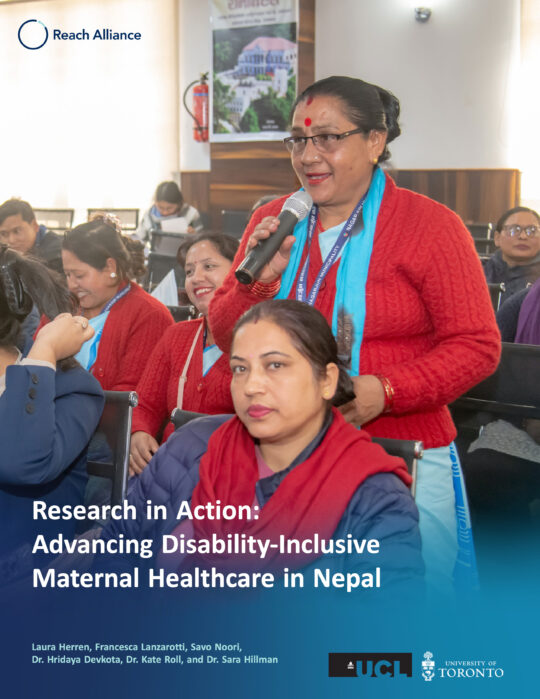Executive Summary
In Peru, 44 per cent of people had anemia in 2017, and over half of rural infants were anemic. People in lower socioeconomic conditions had increased rates. While anemia rates have been decreasing globally, they have remained steady in Peru, even rising in some demographics such as women and children who live in rural or remote areas. Many risk factors for anemia stem from health equity issues, such as poverty, rurality, gender, and food insecurity. The Peruvian Health Ministry’s anti-anemia program focuses on providing education to families to alter their behaviour and consume iron-rich foods such as chicken blood (sangrecita ), liver, and fish. However, providing education and resources on anemia to individual families is difficult and expensive, especially in rural areas.
Because children dislike many of the dietary recommendations which are also unaffordable for most Peruvian families, it can be difficult to adapt such recommendations into everyday lifestyles. The Peru National Plan against anemia also distributes iron supplements to children or women diagnosed with anemia. However, these supplements do not always reach people most in need. Thirty-eight per cent of Peruvians who lack medical institutions live in extreme poverty in rural areas, making access to medical care and iron supplements a challenge.
The work of one local company, Nutri-H, offers an interesting perspective on how public-private partnerships (PPP) can be leveraged to address anemia. Nutri-H produces iron-fortified products, distributed through both government programs and private bodegas, thus increasing access for rural populations by leveraging pre-existing vendor networks. We explore the opportunities and limitations of this informal PPP as a strategy to address anemia in Peru. The innovation has relevance to five Sustainable Development Goals: Zero Hunger (2), Good Health and Well-being (3), Decent Work and Economic Growth (8), Industry, Innovation and Infrastructure (9), and Reduced inequalities (10).
In a series of seven remotely conducted semi-structured interviews with experts and stakeholders actively involved in public-private partnerships or anti-anemia initiatives, we explored the implementation of informal PPPs to address anemia globally and specifically within Peru, the implementation of PPPs like the one between Nutri-H and the Peruvian government.1
Figure 1. A historic area of Lima known for its street art and murals by local artists who portray the culture, beauty, and struggles of people throughout the country’s regions. The local municipality regularly hosts street markets for the benefit of local vendors. (Credit: Fiorella Gaveglio-Fernandez)Iron-deficiency Anemia in Peru
Anemia is a serious global public health problem that affects young children and pregnant women. The World Health Organization (WHO) estimates that 42 per cent of children younger than five years old and 40 per cent of pregnant women worldwide are anemic.2 3
Peru has made considerable efforts to reduce malnutrition and its associated conditions in recent years. The government recognizes malnutrition as a national priority and has committed to developing coordinated strategies involving all levels of government and cross-sectoral partnerships to tackle this problem. 4
Anti-anemia Interventions
The WHO recommends several strategies for managing and preventing anemia, including fortifying and supplementing food, promoting dietary diversity, and informing the population about how anemia can be addressed. The Peruvian Health Ministry has deployed a mix of these strategies in its anti-anemia program, mostly nutrition education to encourage families to consume iron-rich foods such as chicken blood, liver, and fish. The challenge to such an approach, especially in rural areas, is that the remote nature of communities makes the provision of anemia counselling difficult and expensive. Children do not always like the dietary recommendations or they are unaffordable for most families.
As part of the country’s national plan against anemia, iron supplements are distributed to patients who visit medical institutions. However, only 51.5 per cent of the population visit such institutions when they face a serious health problem, and 38 per cent of people who do not have clinics or doctors live in extreme poverty in rural areas, making access to supplements a challenge. Food fortification — the addition of micronutrients to staple foods that are commonly consumed — appears to be a solution.
Figure 2. Ceviche is a classic Peruvian dish with local ingredients. The fresh fish (caught every morning) is cooked in a combination of lime, red onions, and peppers, and served with Peruvian corn, camote (sweet potato), and sometimes seaweed. (Credit: Fiorella Gaveglio-Fernandez)Understanding Food Fortification
Food fortification is a safe and cost-effective method of adding vitamins and minerals, including iron, during the food-processing stage of regularly consumed foods to enhance their nutritional benefits. It is different from food supplementation efforts which involve the consumption of concentrated sources of micronutrients such as vitamins and minerals, and other substances with a nutritional or physiological effect that are marketed in “dose” form. Although iron supplementation generally has a larger impact on population health, food fortification is thought to be a more cost-effective intervention. There are three main food-fortification methods: (1) large-scale food fortification (LSFF), (2) biofortification, and (3) point-of-use or home fortification.5
LSFF involves adding micronutrients to staple foods such as flour, oil, sugar, and salt during the processing stage. An example of this is Ultra Rice which is fortified rice kernels that have a variety of nutritional elements, such as vitamin A, zinc, and iron. It is popular in Brazil, Cambodia, India, Myanmar, and Burundi, in part because a variety of stakeholders involved in its cultivation there have been guided on how to effectively integrate it and overcome obstacles by the nonprofit organization PATH (previously known as Program for Appropriate Technology in Health). LSFF is effective because it can provide much-needed nutrients through staple foods that are commonly consumed.
Instead of adding micronutrients to food, biofortification adds micronutrients during the agricultural growing phase through special fertilizers or plant-breeding methods. This strategy is sufficient for families living in rural areas who farm and sell their own crops. A successful example of this method is golden rice, which was genetically modified to contain beta-carotene, a protein that can transform into vitamin A (which prevents blindness and decreases the chance of getting measles). Biofortification is advantageous because it proposes a sustainable solution to ensure micronutrient intake. However, sometimes people perceive it as being unsafe.
The third strategy is point-of-use or home fortification, where micronutrient powders are added to the food as it is being cooked. Each type of food fortification has its advantages and disadvantages and is used in both high- and low-income countries. For instance, many people use micronutrient powders (MNPs) that contain a variety of vitamins and minerals that do not affect the taste or smell of the food they are added to. For example, “Sprinkles” is an MNP that has been used to address anemia and iron-deficiency concerns in children in Ghana, China, Mongolia, India, and Pakistan. While MNPs are easy to store and transport and are also cost effective, more research is required to conclusively determine how they can best be implemented.
Public-private Partnerships in Food Security and Malnutrition
Implementing interventions for anemia requires the long-term commitment and coordinated action of multiple different stakeholders with non-overlapping interests. Although there is no clear definition of partnership in the food security and malnutrition literature, we find it useful to think of it as “a recognized relationship between two or more partners to work cooperatively towards a set of shared health outcomes in a way that is more effective, efficient, sustainable or equitable than could be achieved by one partner acting alone.”6
Historically, establishing and sustaining partnerships between the public and private sector has not been without its challenges. An enduring difficulty lies in the divergent interests between the two sectors. While the public sector takes the health and well-being of the population as one of its principal concerns, the private sector prioritizes its commercial interests. Because they lack a shared mandate, it is not uncommon for such corporations to design and manufacture food and beverage products that fail to promote health and well-being.
Given their extensive reach and influence, corporations often lobby to change public policy to benefit their own agendas, such as attempting to loosen unfavourable regulations. As a result, there can be a power imbalance between the public and private sector players, conflicts of interest, and mistrust that has strained relationships and occasionally prevented partnerships from forming altogether.
Still, even with existing tensions, efforts to involve the private sector persist. Public-private partnerships continue to be established at all levels, providing optimism about how the two parties can work together to tackle malnutrition. For example, the Global Alliance for Improved Nutrition focuses on enabling and scaling up partnerships that are concerned with food fortification. At the local level, new social enterprises have been created, which carry a dual mandate of promoting the health of the population through nutrition while balancing a business agenda.
Public-private Partnership Success in Micronutrient Deficiency Prevention
There has been a long history of collaboration between governments and industry in the field of food fortification. Such collaborations have led to some successful initiatives, especially when targeting remote and low-income settings. When assessing the suitability of public-private partnerships to address micronutrient deficiencies, both biological and social impact are influenced by the partnership’s structure and by the context in which the initiative takes place.
The first metric for assessing a PPP involves the biological suitability of the product. Ideally, adherence to national legislation can be examined to determine a product’s safety and efficacy. However, when these regulations are not well established, this can prevent scale-up and hinder the potential for impact. There are also often differences in the operating procedures between governments and the food industry, especially in low- and middle-income countries. Private sector actors bring expertise in creating products suitable for and marketable to key audiences, such as young children or low-income households. However, foods that are commercialized for vulnerable populations also have the potential for exploitation. When examining whether a PPP’s product is biologically suitable, researchers need to determine its efficacy, safety, and oversight structure, as well as any possible adverse effects.
Another important dimension of PPPs is social impact. Commonly, PPPs involve collaboration with governmental public health units, which may have low capacity for sustained regulatory monitoring. Monitoring is crucial to ensuring that PPPs are effective and that unintended effects are addressed. PPPs also offer opportunities for positive social impact. A common mechanism through which this occurs is a partnership between social safety net programs (SSNPs) and companies producing fortified foods.
Private sector actors can provide cost optimization and pre-existing distribution networks, while governmental representatives ensure that food is distributed in a socially conscious manner to reach vulnerable populations. However, previous SSNPs have struggled with longevity, especially in precarious times such as the COVID-19 pandemic. We found that successful long-term PPPs in Latin American iron-fortification initiatives tend to engage with media and external branches of government to drive policy change. An example is the successful reduction of anemia in Costa Rica which was driven by iron fortification of foods, leadership from the National Commission on Micronutrients, and support from the private sector.7 8
Food fortification products developed through PPPs never have a neutral social impact. While the products may contribute to improving nutrition, reducing health care costs, increasing economic productivity, and increasing food security, there is a risk of overfortification, negative nutritional trade-offs, or market dominance by one product or company, which exacerbate inequitable access, overdependence on external partners, and negative environmental impact.
Previous Anti-anemia Interventions in Peru
Anti-anemia initiatives in Peru have been chiefly initiated or run by government institutions, with varying participation of local and international nongovernmental organizations (NGOs). For example, the Vaso de Leche (Glass of Milk) program, one of the country’s largest nutritional efforts by government municipalities and local dining halls, began in the 1980s and was successful in reducing anemia for school children by 10 to 30 per cent. Smaller-scale initiatives, such as one in Ayacucho between 2008 and 2015 that introduced local and community-based programs to promote comprehensive care for girls and children under three years of age, reduced anemia for children under the age of five in the Huamanguilla district from 35 per cent to 14 per cent.9
In 2001 the Peruvian congress established nationwide, municipal committees to administer the Vaso de Leche program. They found that municipalities often lacked appropriate funding/organization for proper monitoring and thus limited the program’s ability to truly shift nutritional practices. Urban communities experienced a 48 per cent decline in anemia during the 1996 to 2011 period of economic growth, but no such decline occurred in rural communities over this same time period.10
Government involvement in these initiatives must be across municipalities so efforts aren’t limited to a singular territorial space.
Government involvement in these initiatives must be across municipalities so efforts aren’t limited to a singular territorial space.
Government involvement in these initiatives must be across municipalities so efforts aren’t limited to a singular territorial space.
2. Collaboration for technical, financial, and cultural aid must occur between international NGOs, private stakeholders, local government, and communities.
To make initiatives sustainable over time, there must be community participation that encourages the participation of families and women.11
Hardest to Reach
Anemia is a health condition linked to not only physiological determinants, but also to social, financial, and geographic factors. Women and young children have increased biological needs for iron, meaning that having access to a diet high in bioavailable iron is essential. In regions of Peru where the typical diet has insufficient iron levels to prevent anemia, the government distributes iron supplements to women and children diagnosed with anemia, in accordance with the Peruvian National Health Plan. Many health equity factors interact to make both these anemia care strategies inaccessible to many Peruvians, increasing anemia rates in hard-to-reach populations. One major determinant of anemia is poverty. Data from the 2017 and 2021 Peruvian National Censuses reveal an inverse relationship between household annual income and anemia rates in children under five years of age (Figure 3). Compounding the relationship between poverty and anemia is the ongoing political crisis in Peru.
Historically, Peru has experienced internal conflict in a series of coups and acts of terrorism. As a result of the impact of this instability on food supply chains and social assistance programs, people in many rural areas lack reliable access to healthy foods. Another factor that may make people with anemia hard to reach is geographic isolation. According to data from the 2017 Peruvian census, there is a general positive relationship between the percentage of people living in a rural setting, and measures of anemia (Figure 3). The impact of these social, political, and economic determinants of health result in anemia disproportionately affecting women and children of low socioeconomic status who live in rural areas with little reliable access to iron-rich foods and supplements. Previous government anti-anemia initiatives have a poor track record of improving anemia rates in these hard-to-reach groups.
Figure 3. Distribution of financial, geographic, and physiological data from 2021 and 2017 census.Developing a Consumable Product
In 2018, Julio Garay Barrios, an agro-industrial engineering student at the University of San Cristobal, developed cookies enriched with bovine blood to increase the hemoglobin levels in people with anemia. Bovine blood is typically a wasted by-product of the Peruvian meat industry that pollutes waterways. It has similar nutritional value to meat, milk, and eggs but it’s not often used in food formulation because of its strong odour and flavour. The cookie also contains ingredients that are indigenous to Peru such as quinoa, kiwicha, and cacao. Garay’s innovation is a low-cost alternative to iron supplements and contains 16 milligrams of iron per packet.12
Like many Peruvians, Garay suffered from anemia as a child and his parents helped him recover by feeding him iron-rich chicken blood that they had obtained from sacrificing these animals in the fields.13
Garay experimented with over 300 prototypes to test the colour, taste, and texture of the cookie before finalizing one that was suitable for consumption and tasted good enough to launch as a product. The round cookies have a sweet flavour, good aroma, and a colour that resembles chocolate. They can be consumed on their own or accompanied with a glass of milk, oatmeal, etc. Children are supposed to consume one packet of cookies each day whereas adults (including pregnant women) should consume two to three packets a day. Each packet of Nutri-H cookies contains 2 cookies and costs about CAD 50 cents.
Figure 4. Nutri-H cookies are enriched with bovine blood (sangrecita) to increase the hemoglobin levels in anemic individuals. Bovine blood is typically a wasted by-product of the Peruvian meat industry. The cookie also contains ingredients indigenous to Peru; quinoa, kiwicha, and cacao. Garay’s company, Agroindustria Garay E.I.R.L., launched in 2018. It has since developed seven different Nutri-Hierro products (hierro means iron in Spanish) to address the preferences of different age groups, including oatmeal for infants, chocolate, a vegetarian option, and panettone. Nutri-Hierro or Nutri-H has also developed cereal made from Andean grains, DHA, and omega 3 to improve children’s cognitive development. (DHA is considered an essential nutrient during pregnancy and lactation because it promotes the development of the nervous system in the first years of life. It also helps prevent brain aging and some neurodegenerative diseases in adults.) The company has also developed cookies that use refined fish oil or spirulina instead of bovine blood to cater to people who cannot consume blood.
In 2019, Nutri-H opened a production plant that can produce 10,000 cookie packages per hour in Garay’s hometown, Ayacucho. The town located, 2,760 metres above sea level in the Andean highlands southeast of Lima, is the capital of the Huamanga province. As a result of its remote location, the people of Ayacucho experience food insecurity because food is seasonally unavailable. People also find it difficult to transport necessities such as imported food and clothes. Weather and potential crop loss also affects the region’s food availability. The region was also greatly impacted by the bloody internal conflict in Peru’s recent history (1980–2000). Ayacucho has 616,176 inhabitants (2.1% of the national population), almost 9 per cent of them children under the age of five.14
Gaining Recognition
Garay entered his innovative cookie to compete in the History Channel Latin America’s “Una Idea” (One Idea) contest in late 2019 as an opportunity to promote his product regionally. Since 2014, the yearly contest had received more than 30,000 ideas from 15 countries. While the public can vote for their favourite innovation, the first, second, and third place winners are chosen by judges. His entry captured the interest of the Peruvian media, which together with the ministries of Education, Agriculture, Culture, Defence, and the Presidency of the Council of Ministers, urged the public to support him with their votes. In January 2020, Nutri-H won the first prize of USD 60,000.
Nutri-H Partnerships and Distribution
After demonstrating the Nutri-H cookies’ impact in school pilots and medical clinics in seven communities in Ayacucho, the company signed agreements with the Lima municipalities of Ventanilla and San Miguel to incorporate the cookies into their social programs against anemia. Since its launch, the company has secured partnerships with governments to distribute cookies through social programs in many other regions in Peru including: Puno, Huancané, and Orurillo in the Puno region; José Luis Bustamante y Rivero in Arequipa; the provincial municipality of La Merced and the commune of the district of San Agustín de Cajas in Junín; the city of Tacna; the commune of the district of Coyllurqui in the Apurímac region; the districts of Santillana and Chiara in the Ayacucho region; and the district of Santo Domingo de Olleros in the Lima region.
The company is also eager to distribute its innovative cookie through a national school nutrition program called Qali Warma . The government social initiative aims to improve children’s nutrition and health through school meals. The name Qali Warma , which means “vigorous child,” is derived from the Indigenous Quechua language. Qali Warma looks to combat the increasing availability of ultra-processed foods, normally high in sugar and fat, that are easily accessible at school kiosks, local bodegas, and shops. The program promotes healthy eating habits among youngsters through nutritious, culturally relevant meals provided at schools, via common ingredients such as enriched milk, cereal, quinoa, and kiwicha. It educates students on the importance of balanced diets, food safety, and hygiene. Community involvement and parental participation reinforce these lessons at home. Regular monitoring ensures meal quality, and collaborations encourage physical activity. The 2014 “Healthy Learning” initiative (Aprende Saludable ) had this intersectoral approach using Qali Warma and the work of other government ministries to ensure a holistic approach to nutrition. Special dietary needs, in terms of specific deficiencies and the incorporation of indigenous foods, are addressed, ensuring that all children receive proper nutrition. The program’s holistic approach aims to enhance children’s overall well-being by not only improving their physical health but also supporting their educational success. Children in early learning and elementary education are the major focus of Qali Warma but the initiative also includes high-school students to benefit Indigenous children in the Peruvian Amazon.
The program was first implemented as a three-year initiative by the Ministry of Development and Social Inclusion of Peru in 2012 in partnership with the United Nations Development Programme (UNDP) but after its success, it was extended to 2022. The program provides healthy school lunches to students, improving eating habits among children while simultaneously engaging with local communities and providing people with food education. Qali Warma’s objectives align with those of Nutri-H. As Garay put it, “We have already met [Qali Warma] — the nutritional information sheet of the cookie meets Qali Warma’s requirements. It [the cookie] already has the health permit; but you have to make some technical and cost adjustments. We are waiting for their response.”15
The company has secured distribution through major commercial retailers such as Oxxo and the online retailer Rappi, allowing for Peruvians in more urban areas to purchase their products. Sales in urban areas where people have higher purchasing power enable the company to engage with governments and NGOs to distribute their products through their social programs that purchase cookies in bulk at a subsidized cost because the people who most need the anti-anemia products are not actually able to purchase them themselves.
The company has been raising its reputation globally and is in talks to start exporting its products to other countries that also face public health problems associated with anemia. Nutri-H products are a low-cost, low-tech innovation that adapts the food industry’s waste products in a culturally appropriate way for a sustainable solution to anemia. The company’s novel corporate structure blends public and private sectors to incentivize the distribution of its products to those who need it most.
Gender
In Latin America, anemia significantly affects children and women of reproductive age, leading to poor growth and decreased cognitive function in children. Anemia is a public health problem in 16 out of 17 countries in the region for women of reproductive age and in 15 countries for children under the age of five. Latin America has a long history of implementing policies and programs to eradicate micronutrient deficiencies which have led to the reduction of many of these deficiencies. However, numerous gaps still exist and in many cases the deficiencies are still public health problems in the region. Nutri-H’s products are designed to address the nutritional needs and tastes of both children and their mothers.
Nutri-H’s Success Story and Continuing Challenges
Initial research by both Nutri-H and the Universidad César Vallejo has confirmed the cookies’ success at raising hemoglobin levels in seven Peruvian communities where the cookies were provided to school-aged children and pregnant women. Children in the programs saw an almost 100 per cent increase in their hemoglobin levels in just over 30 days. Pregnant women who consumed the cookies had their hemoglobin levels raised by 15 per cent in 40 days.
Since 2018, Nutri-H has grown and its reach extends to 22 of 25 Peruvian regions. In some regions, bodegas bulk purchase the product from Nutri-H and sell it to consumers at roughly the cost of a normal packaged cookie, ensuring its competitiveness with other brands. Over 22 municipalities have also partnered with Nutri-H to directly purchase the product and distribute it to at-risk populations for free as a component of their social assistance program. However, there are still barriers to success.
An expert in innovation and entrepreneurship told us that rural areas are not profitable, and it is difficult to scale up. That said, because the company does not aim to earn money but to provide a service, its success can be measured in terms of the quantity consumed rather than the revenue generated. In another interview, we heard that Nutri-H measures the impact of its visibility within the media. Many individuals who purchased the product heard about it through national media and social networks (e.g., banners, broadcast on the radio, etc.). Nutri-H also collects reports from the districts and municipalities where the products are distributed and asks how many cookies have been delivered and how many children are improving in terms of hemoglobin level.
Julio Garay Barrios has ambitions to tackle a social problem that affected him as a child by designing a social awareness strategy that educates about anemia not just in Peru, but globally. The company currently aims to expand in Peru where they are trying to reach different municipalities through alliances and agreements with universities, bodegas, and pharmacies.
Barriers and Challenges
A significant challenge in anti-anemia interventions is the lack of financial sustainability in the distribution of anti-anemia products. To date, no anti-anemia product has been able to be both financially self-sustaining and succeed in reaching the most vulnerable populations. Garay described the dual distribution of Nutri-H products — through both private bodegas and governmental social assistance programs — as a unique dynamic. An expert in innovation and entrepreneurship highlighted that although the Nutri-H cookies are more costly for bodega owners compared to competitors on the shelf, this cookie should be compared to medicine because it is a method to prevent anemia. However, with such a product, the significant costs associated with distributing or reaching the target market can prevent consumers from purchasing the product in the open market. Government partnerships could help reduce the costs.
Because this particular anti-anemia product is produced in a region of the country that is not as well connected as Lima, distribution costs are an issue. Peru is a centralized country and a large part of the population resides in Lima. Travelling outside of Lima often requires air travel because of the country’s mountainous terrain. Since the Nutri-H products are currently manufactured in Ayacucho, which is eight hours away by bus and one hour away by plane to Lima, transportation costs can multiply rapidly.
The COVID-19 pandemic took a toll on government strategies used to address anemia. The public health system was severely affected by the pandemic. Despite strict lockdown regulations, Peru had one of the highest rates of death from the COVID-19 virus in the world. Local hospitals lacked resources such as beds and oxygen tanks. The poorest people were forced to make the difficult decision of staying home to avoid the harms of the pandemic or selling products in street markets for their livelihoods. With stronger lockdown regulations, it was challenging if not impossible for the people who largely made a living in the informal economy to procure nutritious meals or pay to see a doctor.
The pandemic highlighted significant economic difficulties that were already facing many Peruvians prior to 2020. One expert in innovation and entrepreneurship in the Peruvian context told us that the pandemic made everyone more aware of people’s hardships, and inspired more people to think of opening businesses that were compassionate and considered social and environmental issues — that making money does not need to conflict with helping people. “The good side is where there’s chaos, there’s a lot of opportunities, and a lot of things that can be solved because there is a solution. I mean … this is why we have so many entrepreneurs that are thinking and trying to solve them like Julio. Optimistically speaking, I think that we are going to see more Julios, not just in Peru, but in the world soon enough. I think COVID-19 has made us more human. And more people are thinking of opening businesses that are more friendly with humanity, with social issues, with environmental issues.”
Lessons Learned
While partnerships between the public and private sector in food security and malnutrition are not without their challenges, there is reason to be optimistic about the collaborations between the public and private sector in combatting anemia. Iron-deficiency anemia is a global issue that affects many countries and requires a combination of complex solutions and coordinated efforts between participants across sectors.16
Government Support of Small and Medium-sized Businesses
One of the key difficulties that small- and medium-sized businesses in the food industry face is gaining access to sustainable financing to support operations. Unlike larger food corporations, smaller businesses do not necessarily have consistent revenue and are potentially denied loans from creditors because of the inherent risks they pose. Nutri-H, a new and small business with fewer than 100 employees, was not immune to this problem. To date, it has been able to survive through nonrecurring grants provided by the Peruvian government’s innovation program and the revenue generated from selling to regional government and some retailers. Without the government’s purchase of their products, it is unclear how long the business can continue to persist, particularly in an economic environment that is unfavourable for smaller businesses. As one interviewee noted, few entrepreneurial firms like Nutri-H exist in Peru and when they do appear, they tend to relocate to other countries that offer better regulations and support. Political stability is also crucial to the implementation of programs to distribute a solution like Nutri-H. One interviewee from a local nonprofit organization noted the challenges of Addressing Anemia in Peru: Nutri-H’s Iron-Fortified Solutions 13 implementing and maintaining the continuity of these programs: “So we were on a meeting: we had agreements — we knew the way that we wanted to work together and articulate. Two weeks later, [the government official we were working with] would be gone, and so on. So that’s one of the problems now — there is no continuity because the people keep changing and changing local authorities and other people that come below.” Regional governments can strengthen their programs to provide stronger incentives for local businesses like Nutri-H to emerge, which will provide a boost to the economy. Nutri-H was born out of a local Peruvian’s vision — someone who is truly invested in solving the problem of anemia. Governments should recognize this local solution because the man’s story can alleviate people’s concerns about the product’s trustworthiness.
Government Logistical Support Critical to Distribution
Several interviewees emphasized how important it is for government to be involved in the distribution of anti-anemia products like Nutri-H to maximize the intervention’s reach. One interviewee who had experience in establishing anti-anemia initiatives with PPP involvement commented, “the role of the private sector was to make the product … not to do the distribution.”
According to another interviewee from a local nonprofit organization, it was critical to involve government to ensure that the needs of the hardest to reach are met. “You need to have the state involved because you’re not going to be able to reach the magnitude of the territory that you need to reach if you don’t.” While it is also important to address anemia in more densely populated areas like Lima, anemia prevalence is higher in more rural and remote areas of Peru. These areas are often not well connected to bigger cities or hubs and therefore experience food insecurity, which is significantly associated with anemia prevalence. Government involvement in transporting and distributing the anti-anemia products, whether at the local or national level, enables small- or medium-sized companies like Nutri-H to reach populations that need them most. Local governments or community leaders’ involvement in the distribution process also ensures that the recipients trust and consume the
Earning Trust
Trust between key stakeholders within the publicprivate partnerships and consumers is imperative when managing and distributing products. Political commitment is one of the most important points in implementing and sustaining projects, so if new governments come to power, that political commitment to an initiative can often be lost. Since 2021, Peru has had seven different health ministers. Such political instability has tangible impacts on government’s ability to reach these communities. One interviewee told us that in their experience, if the party leader accepts something then the ministries, secretaries, and everybody else is bound to accept it too. People tend to not trust the government, but they trust other people.
An expert in innovation and entrepreneurship highlighted that once the first stage of conceptualizing the product has finished and evidence-based research has backed it up, the product still needs to be accepted by the consumers. Mothers, for example, typically take on many challenges but not if it puts their own children at risk. Other anti-anemia initiatives around the world have found social marketing effective at communicating with the target population and increasing a product’s acceptability. When launching a product into the desired community, the message must be from a credible source, have multiple local stakeholders involved, and ensure there are no issues with cultural resistance if it’s going to foster trust. Garay Barrios does all this. He goes from Addressing Anemia in Peru: Nutri-H’s Iron-Fortified Solutions 14 city to city to speak with relevant stakeholders and introduce his products to the locals who will benefit the most from the anti-anemia products. His persistent and active promotion of his innovation has not only contributed to the reduction of anemia among children in Peru (the proportion of anemic children in Peru fell from 46.1 to 41.1 percent between 2018 and 2019, according to data by the National Institute of Statistics and Computer Science of Peru), but it has also inspired the country to look to locally developed solutions for local problems.
His personal approach in championing his innovation has also enabled him to build connections with rural and remote communities who are often hesitant to trust or collaborate with authorities. According to an interviewee who works in a local nonprofit organization, “what I always say is you need to have an authorized — in Spanish, it’s called interlocutor — the person in between you and the community has to be a person from the community. Right? You start a relationship with one person or with a very small group of people and work with them in order to reach the community. Because we are outsiders, we don’t speak [like them], we look different. We speak differently. And they’re very much used to being patronized. So you need to go through someone from the community and that is fieldwork. You need to go and get to know the community — you need to let them know [you].”
The private sector is not always fully aware of the strategic priorities and public policies set by the Peruvian government for tackling anemia. This lack of knowledge can preclude its involvement in improving the health of the population. Our conversations with an interviewee from the United Nation’s World Food Programme (WFP) revealed that mediators can be particularly helpful in bridging the information gaps that exist between the two sectors. In fact, WFP currently serves as an intermediary between sectors in the country. As a well-recognized and major international humanitarian organization, it is trusted. WFP not only works extensively with the Peruvian government in shaping the country’s food strategy but it also brings together the government and the private sector to discuss policies, projects, and the results of anemia initiatives in select territories. In the case of Nutri-H it is not clear whether mediators facilitate any links between the company and the government, but Garay Barrios told us that they have been able to complement the municipalities’ Vaso de Leche (Glass of Milk) programs, consistent with overarching state objectives.
Acknowledgments
As researchers we acknowledge our position as settlers on the land on which the University of Toronto operates. For thousands of years, it has been the traditional land of the Huron-Wendat, the Seneca, and the Mississaugas of the Credit. Today, this land is still home to many Indigenous people from across Turtle Island and we are grateful to have the opportunity to work on this land. We are grateful to those we interviewed for sharing their insights with us. We also thank the following organizations: Nutri-H, CARE Peru, Peruanos por Peruanos, and World Food Programme. Finally, we express our sincere appreciation to Michael Alcorn, Moni Kim, Emma Sanchez-Swaren, Filsan Dualeh, and Jacqueline Larson for their guidance and mentorship throughout our research project.
This research was vetted by and received approval from the Ethics Review Board at the University of Toronto. The research was conducted virtually because it was deemed unsafe to travel for field work due to the precarious political climate in Peru during the first six months of 2023.
MASTERCARD CENTER FOR INCLUSIVE GROWTH
The Center for Inclusive Growth advances equitable and sustainable economic growth and financial inclusion around the world. The Center leverages the company’s core assets and competencies, including data insights, expertise, and technology, while administering the philanthropic Mastercard Impact Fund, to produce independent research, scale global programs, and empower a community of thinkers, leaders, and doers on the front lines of inclusive growth.
MUNK SCHOOL OF GLOBAL AFFAIRS & PUBLIC POLICY
The Munk School of Global Affairs & Public Policy at the University of Toronto brings together passionate researchers, experts, and students to address the needs of a rapidly changing world. Through innovative teaching, collaborative research, and robust public dialogue and debate, we are shaping the next generation of leaders to tackle our most pressing global and domestic challenges.







